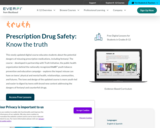
Building school environments which prevent drug use before it starts.
- Subject:
- Health Education
- Health/Physical Education
- Material Type:
- Reading
- Visual Media
- Date Added:
- 10/24/2023

Building school environments which prevent drug use before it starts.

The Love Like Adam Foundation was established in honor of Adam Jeffrey Oakes, a freshmen at Virginia Commonwealth University when his life was tragically cut short on February 27th, 2021 from hazing. The foundation is dedicated to raising awareness of the potential dangers students face on college campuses. This includes but is not limited to
hazing, signs of alcohol poisoning and bystander intervention. Visit the website at www.lovelikeadam.com.

This newly updated digital course educates students about the potential dangers of misusing prescription medications, including fentanyl. The course – developed in partnership with Truth Initiative, the public health organization behind the nationally recognized truth® youth tobacco prevention and education campaign – explores the impact misuse can have on teens' physical and mental health, relationships, communities, and futures. The tone and design of the updated course is more youth-led and easier to digest by teens with brand new content addressing the dangers of fentanyl and counterfeit drugs.
Registration Required.
Free.

To read this graph, start by looking at the title and labels. The title tells you what the graph is about, and the labels on the axes show you what is being measured. Once you understand the labels, look at the data points. These are the dots or bars that represent the information. You can compare the data points to see how the values change over time or in relation to each other.As you scroll your mouse over the various data points, you will learn about the different stimulants that are being combined with opioids and the number of deaths from these lethal combinations that have been reported since 2012. The second graph depicts methamphetamines and cocaine and their involvement in opioid-related deaths.

This video explains how opioids affect the brain by slowing down pain signals through opioid receptors, mimicking the brain's natural endorphins. Over time, as a person like Susan continues taking opioids, her brain becomes tolerant, requiring higher doses for relief, which can lead to addiction and a challenging cycle of dependence.
[National Geographic]